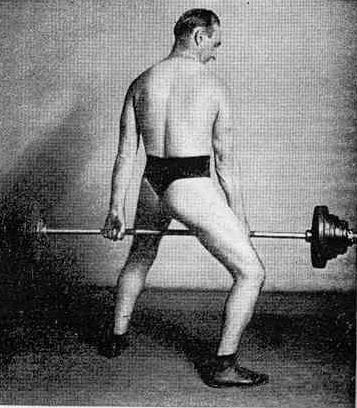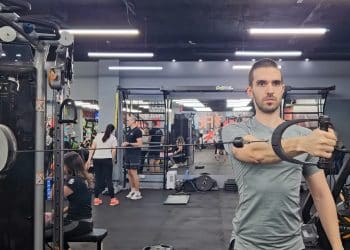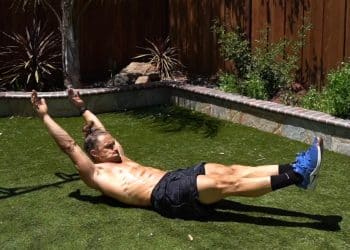Stretching is good for everybody’s body. Tight muscles can affect your posture and range of motion, contributing to injury (1). Prolonged sitting and sedentarism mean many people experience tight muscles and need to stretch more.
However, stretching is time-consuming, and some people find it boring. As such, many lifters spend very little time working on their flexibility. Some will stretch briefly between sets or at the end of their workouts, while others skip it entirely. Either way, it’s easy to see why so many people have such tight, short muscles.
As a personal trainer with over 30 years of experience, I make sure all my clients spend at least 10-15 minutes working on their flexibility. I also prescribe stretching ‘homework” for those clients who are particularly tight.
One stretching exercise that is gaining traction is the Jefferson curl. It promises rapid increases in hamstring flexibility, and some fitness experts suggest it can help alleviate lower back tightness and pain. As such, there is a lot of interest in this “secret” hamstring stretch.
While the Jefferson curl can be effective for some, it’s not suitable for everyone. It could even make some existing lower back problems worse. In this article, I reveal how and why to do the Jefferson curl so you can decide if it deserves a place in your workouts.
How to Do Jefferson Curl with Correct Form
Proper form is critical during every exercise, but especially the Jefferson curl. Doing this exercise incorrectly could cause severe lower back injuries. As such, make sure you study these instructions and watch the video to avoid mistakes. Also, use a very light weight. This exercise is a stretch first and a strength builder second.
Level Up Your Fitness: Join our 💪 strong community in Fitness Volt Newsletter. Get daily inspiration, expert-backed workouts, nutrition tips, the latest in strength sports, and the support you need to reach your goals. Subscribe for free!
- Stand on a sturdy plyo box with your feet together and your legs straight.
- Hold a light barbell, dumbbells, or kettlebell (e.g., 5-10 pounds) in front of your legs, i.e., an overhand grip. Brace your core.
- Shrug your shoulders forward, put your chin on your chest, and roll down one vertebra at a time, lowering the weight down the front of your legs.
- Lean forward and reach for the floor.
- Descend as far as your flexibility allows, and then pause for a few seconds.
- Reverse the movement by coming back up one vertebra at a time.
- Stand up straight and repeat.
Jefferson Curls: Muscles Worked
Jefferson curls are primarily a hamstring stretching and spinal mobility exercise. As such, they’re typically done using light weights and won’t do much for your strength or muscle size.
That said, advanced exercisers and athletes may progress to doing this exercise with heavier loads. This turns this stretching exercise into a strength builder.
The muscles involved in Jefferson curls are:
Hamstrings
The hamstrings are the main muscle you’ll feel working and stretching during Jefferson curls. There are three hamstring muscles: the semimembranosus, semitendinosus, and biceps femoris. The hamstrings cross your knees and hips, making them a biaxial muscle.
Gluteus maximus
Known as the glutes for short, this is the largest muscle in the human body. The glutes are located on the back of your pelvis and hips and are responsible for hip extension. They also play a part in hip stability.
Erector spinae
The erector spinae is the name we give the muscles that run up either side of your spine. They’re responsible for spinal extension and lateral flexion. There are three major erector spinae muscles: the iliocostalis, longissimus, and spinalis. Each one affects different regions of the spine, controlling its movement and maintaining posture.
Core
Core is the collective name for the muscles of your midsection. These include the rectus abdominis, obliques, and transverse abdominis. The core contracts inward to create intra-abdominal pressure, which supports your spine and takes pressure off the intervertebral discs and ligaments. You activate these muscles when you brace.
Spine
As you probably know, the spine is not a muscle. Rather, it’s the collective name for the 33 vertebrae that make up your back. The spine comprises five sections:
- Cervical – neck (7 vertebrae)
- Thoracic – mid-back (12 vertebrae)
- Lumbar – lower back (5 vertebrae)
- Sacral – base of the spine (5 fused/immovable vertebrae)
- Coccygeal – “tail bone” (4 fused/immovable vertebrae)
The cervical, thoracic, and lumbar vertebrae are separated by tough, flexible cartilaginous pads called intervertebral discs. These discs allow your spine to move and act as shock absorbers. The vertebrae are also connected by ligaments and controlled by small muscles, including the interspinealis and rotatores muscles.
Jefferson curls help mobilize the cervical, thoracic, and lumber vertebrae and stretch and strengthen all of the associated muscles.
Pro-Trainer Tips
Get more from Jefferson curls with these tried-and-tested pro-trainer tips!
Contract your quadriceps – tensing your quads helps keep your legs straight while stabilizing your knees. As an added benefit, when you contract your quads, your hamstrings tend to relax more. Imagine pulling your kneecaps up your thighs to fully engage your quadriceps.
Imagine your spine is a chain – the aim of the Jefferson curl is to flex each vertebra in sequence. To achieve this, think of your spine as a chain. Tilt your chin toward your chest and lean over by moving one vertebra or chain link at a time. Come up one vertebra at a time, starting with your lumbar spine or lower back.
Time your breathing to your movements – inhale as you lean forward and exhale as you stand back up. This will enhance abdominal bracing and reduce the stress on your lumbar spine. Breathe into your abdomen and not your chest. Never hold your breath.
Master the movement before adding weight – you don’t need a lot of weight to benefit from Jefferson curls. As little as 5-10 pounds is enough for most. Only add more weight if you a) have mastered the exercise and b) feel you’ll benefit from more weight.
Take it slow – the Jefferson curl is a technically and mechanically demanding exercise. It puts your spine in a potentially weak position. As such, you should introduce this exercise gradually and avoid overdoing it. While the Jefferson curl can be beneficial, overexuberance could lead to injuries.
Build your range of motion – don’t worry if you can’t do deep Jefferson curls. Make a note of how far you can descend, and gradually work on going deeper as your mobility and flexibility improve. However, never rush your progress, as doing so could lead to injury.
Jefferson Curl Mistakes to Avoid
Make Jefferson curls as safe as possible by avoiding these common mistakes.
Bending your knees – it’s natural to want to bend your knees as you lean forward during Jefferson curls. After all, that makes the movement more manageable and comfortable. However, you should keep your knees locked during this exercise to maximize the stretch in your hamstrings.
Hinging from the hips – most forward flexion exercises start with a hip hinge, e.g., Romanian deadlifts and kettlebell swings. And while you will hinge at the hips during Jefferson curls, most of the movement should come from your spine. Do not push your hips back during Jefferson curls. Instead, try to keep your hips over your feet.
Worrying about how much weight you’re lifting – unless you are very experienced, the weight you use for Jefferson curls is not important. The function of the weight is to pull you gently into a deeper stretch, not build muscle or strength. Your position means it won’t take a lot of weight to achieve this.
So, don’t worry if 5-10 pounds is all you need. Use the lowest weight that gives you the desired result. More weight means a higher risk of injury.
Descending too fast – sinking too fast during Jefferson curls makes the exercise less effective. “Divebombing” creates a rapid stretch, which, in turn, triggers a powerful counter-contraction, limiting your range of motion. Descending slowly helps your muscles relax so you can stretch further.
Ignoring pain – no pain, no gain, right? While that may be (sort of) true for some exercises, it’s not the case with Jefferson curls. While some can perform this exercise safely, it’s not suitable for everyone. So, if it hurts you, make sure you stop. Use a lighter weight, reduce your range of motion, or skip this exercise entirely if it causes pain.
Jefferson Curl Benefits
Not sure if Jefferson curls deserve a place in your workouts? Consider these benefits and then decide.
Increased hamstring flexibility – at its heart, the Jefferson curl is a powerful exercise for improving hamstring flexibility. Using a weight pulls you into a deeper stretch than you could achieve without one. As such, if you want to unlock your flexibility and lengthen your hamstrings, the Jefferson curl could help.
Level Up Your Fitness: Join our 💪 strong community in Fitness Volt Newsletter. Get daily inspiration, expert-backed workouts, nutrition tips, the latest in strength sports, and the support you need to reach your goals. Subscribe for free!
Improved spinal mobility – the Jefferson curl enhances your cervical, thoracic, and lumbar spine mobility. If you are generally sedentary, these joints can become stiff. Jefferson curls can help restore normal range of motion to your spine.
Enhanced kinesthetic awareness – Jefferson curls teach you to be more aware of the position and movements of your spine. After all, to do this exercise correctly, you must move each vertebra independently. This will develop your kinesthetic awareness, which is your ability to sense the position and control your limbs without seeing them.
Increased strength in a flexed position – fitness experts generally advise people to lift with a neutral or slightly arched lower back. This makes sense as this is a very stable position. However, it’s not always possible. The events of everyday living mean that, sometimes, you have to lift with a rounded lower back. Jefferson curls build strength in this rounded or flexed position.
Reduced fear of rounding your back – leading on from the point above, many people are scared of rounding their lower backs. However, spinal flexion is perfectly natural and, providing it’s not done with very heavy loads, is perfectly safe (2). Therefore, eliminating spinal flexion from your workouts can lead to injuries when you perform this movement unexpectedly.
Jefferson Curl Programming
Jefferson curls are best introduced gradually and cautiously. Going too hard and heavy too soon could result in severe injury. As such, when doing this movement for the first time, you should use light weights, 5-10 pounds being ideal. Limit yourself to three to five slow, controlled reps per set. Two to four sets should be plenty for most people.
Regarding frequency, as this is predominately a stretching and mobility exercise, it won’t be overly fatiguing. Consequently, you can do it every other day, i.e., 3-4 times a week. However, I don’t suggest doing it daily, as this could cause unnecessary wear and tear of your spine, ligaments, and discs.
Increase training volume before you increase your weights. In other words, work up to 3-4 sets of 8-10 reps before adding load. Even then, use small increments to avoid overloading your spine.
You can do Jefferson curls as part of your warm-up to prepare your muscles and joints for the hard work to come. Alternatively, you can do them at the end of your session when your muscles are warm and need a stretch. Done gently, they’re also a great way to break up long periods of sitting or any time your lower back feels tight.
However, my preferred option is to do them as part of a comprehensive flexibility program. That way, you can do some basic hamstring and lower back stretches beforehand, maximizing the potential benefits of this powerful exercise.
Jefferson Curl Variations
1. Bodyweight Jefferson curls
For some exercisers, even 5-10 pounds will be too heavy for Jefferson curls. Don’t worry –unweighted Jefferson curls can be effective. Perform the movement as described above but without a barbell, dumbbells, etc. This is a good exercise for beginners, those with a weak lower back, or as a warm-up for the weighted variation.
2. Floor barbell Jefferson curl
Standing on a raised platform lets you lean forward without your weight or hands touching the floor. As such, the platform is essential for people with above-average flexibility.
However, you won’t need to stand on a platform for Jefferson curls if you can barely touch your toes. So, if you are still quite immobile, do your Jefferson curls standing on the floor. This will also make balancing easier, making the exercise less intimidating.
3. Straddle Jefferson curl
The straddle Jefferson curl puts a little extra slack in your hamstrings. Consequently, you can lean forward more comfortably while focusing on the movements of your spine. This is a good option for anyone with short, tight hamstrings. Gradually bring your feet closer together as your flexibility improves.
4. Reverse Jefferson Curl
Where regular Jefferson curls start at your neck and work down, the reverse version starts at your lumbar spine and works up. This exercise requires no additional equipment, and you can do it standing on the floor, so it’s ideal for home and outdoor workouts.
Jefferson Curl Alternatives
Not sold on Jefferson curls? I hear you! Here are a few exercises you can do instead.
1. Romanian deadlifts
Romanian deadlifts, known as RDLs for short, are one of the best exercises for strengthening your posterior chain. They also provide a decent stretch for your hamstrings. However, because they involve a hip hinge and your lumbar spine is slightly arched, they’re easier on your lower back than Jefferson curls. This is a good option if you prefer to use heavier loads.
2. Good mornings
Good mornings are so-called because, when you do them, you look like you are bowing politely to greet someone. Peculiar names aside, this is another excellent posterior chain exercise that also stretches your hamstrings. However, holding the load on your back instead of in your hands means your lower back has a lot of work to do during this exercise.
3. Assisted Hamstring stretch
Jefferson curls stretch your hamstrings. However, things like lumbar spine health and core strength may mean you cannot do them well enough to maximize flexibility. Assisted hamstrings stretches are lower back-friendly, and allow you to extend your muscles as far as you wish. While this exercise won’t build strength, it will improve your flexibility.
Jefferson Curls FAQs
Do you have a question about Jefferson curls? No problem, because I’ve got the answers! Need more information? Drop me a line in the comments section below, and I’ll get back to you ASAP.
1. Are Jefferson curls safe?
While no exercise is 100% safe, I believe that Jefferson curls are a pretty high-risk exercise. While some people can do them without issue, many others cannot. Lifting a weight with a rounded back puts a lot of stress on your intervertebral discs and ligaments. These structures, if damaged, take a long time to heal and may even require surgery to repair.
That’s not to say you shouldn’t do this exercise. However, you must weigh up the pros and cons before trying it. For example, if you are an elite gymnast looking to increase your already high level of flexibility, Jefferson curls could be the solution you’ve been looking for.
In contrast, if you are a beginner or general exerciser with average flexibility, there are plenty of safer exercises you can do instead.
2. Why are they called Jefferson curls?
Jefferson curls are so-called because of the famous strongman and circus performer Charles Jefferson. Jefferson was well-known for lifting heavy objects with a rounded lower back. The Jefferson squat is also named after him.

3. How much weight should I use for Jefferson curls?
If you have never done Jefferson curls before, I suggest learning the movement without weight. This will help you determine if you can perform them comfortably and safely. Then, after a couple of workouts, you can graduate to 5-10 pounds. Use that weight for a few weeks, getting used to the movement and working on increasing your flexibility.
Because of the risk of injury, you should use the least amount of weight possible to achieve your goals. So, if 15 pounds delivers a deep stretch, there is no benefit to going heavier.
That said, if strength is your goal, and you can do so without hurting yourself, you can gradually increase the load as you get stronger. However, never sacrifice more weight for good form. And remember, there are other exercises better suited to lifting heavy weights, such as the barbell and Romanian deadlifts.
Closing Thoughts
The Jefferson curl is a controversial exercise with numerous pros and cons. On the one hand, they’re an effective way to stretch your hamstrings and mobilize your spine. But, on the other, there is a higher-than-average risk of injury, and they are probably too advanced for general exercisers.
Do I prescribe this exercise to my clients? Yes – on occasion.
However, I tend to save Jefferson curls for experienced athletes who need extreme flexibility for their chosen sport, e.g., gymnasts, divers, and MMA fighters. For everyone else, I believe the potential risks outweigh any benefits, and there are safer ways to achieve the same goals.
Does this mean that Jefferson curls are a bad exercise? Certainly not! But they’re not for everyone, and most exercisers can achieve their fitness goals without doing them. If you do try Jefferson curls, remember to start light and progress slowly. This is not an exercise rush or underestimate.
References:
- Witvrouw E, Danneels L, Asselman P, D’Have T, Cambier D. Muscle flexibility as a risk factor for developing muscle injuries in male professional soccer players. A prospective study. Am J Sports Med. 2003 Jan-Feb;31(1):41-6. doi: 10.1177/03635465030310011801. PMID: 12531755.
- Saraceni N, Kent P, Ng L, Campbell A, Straker L, O’Sullivan P. To Flex or Not to Flex? Is There a Relationship Between Lumbar Spine Flexion During Lifting and Low Back Pain? A Systematic Review With Meta-analysis. J Orthop Sports Phys Ther. 2020 Mar;50(3):121-130. doi: 10.2519/jospt.2020.9218. Epub 2019 Nov 28. PMID: 31775556.
Featured Image via @TSTMethod on YouTube!
Interested in measuring your progress? Check out our strength standards for Good Morning, Deadlift, Hip Extension, and more.












